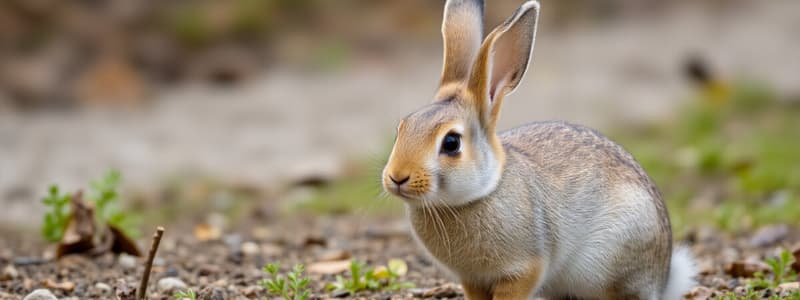Podcast
Questions and Answers
What was the primary food source for the rabbit population before the climate change?
What was the primary food source for the rabbit population before the climate change?
- Drought-tolerant shrubs
- Hawks
- Tall grasses (correct)
- Insects
The change in fur color of the rabbits was an example of adaptation to the changing environment.
The change in fur color of the rabbits was an example of adaptation to the changing environment.
True (A)
What was the primary factor that led to the decline of tall grasses in the grassland?
What was the primary factor that led to the decline of tall grasses in the grassland?
Climate change causing hotter, drier conditions
The rabbits with ______ fur became more common because they were better camouflaged in the new environment.
The rabbits with ______ fur became more common because they were better camouflaged in the new environment.
Match the following environmental changes with their impact on the grassland ecosystem:
Match the following environmental changes with their impact on the grassland ecosystem:
Which of the following best describes the relationship between the change in vegetation and the rabbit population's fur color?
Which of the following best describes the relationship between the change in vegetation and the rabbit population's fur color?
Based on the passage, which of the following statements best reflects the concept of 'natural selection'?
Based on the passage, which of the following statements best reflects the concept of 'natural selection'?
If the climate conditions reversed, returning to a lush environment with abundant tall grasses, what would be the most likely outcome for the rabbit population's fur color?
If the climate conditions reversed, returning to a lush environment with abundant tall grasses, what would be the most likely outcome for the rabbit population's fur color?
Which of the following best describes the role of the climate change in the scenario presented?
Which of the following best describes the role of the climate change in the scenario presented?
Flashcards
Climate change effects
Climate change effects
The impact of climatic shifts on ecosystems and species, leading to changes in habitat and population dynamics.
Survival of the fittest
Survival of the fittest
A natural selection principle where traits that enhance survival are passed to future generations.
Rabbit coloration adaptation
Rabbit coloration adaptation
The occurrence of brownish-gray fur in rabbits, which helps them blend into their changing environment and avoid predators.
Drought-tolerant shrubs
Drought-tolerant shrubs
Signup and view all the flashcards
Impact on biodiversity
Impact on biodiversity
Signup and view all the flashcards
Tall grasses decline
Tall grasses decline
Signup and view all the flashcards
Brownish-gray fur rabbits
Brownish-gray fur rabbits
Signup and view all the flashcards
Climate-induced predator evasion
Climate-induced predator evasion
Signup and view all the flashcards
Impact on herbivore populations
Impact on herbivore populations
Signup and view all the flashcards
Drought effects on ecosystems
Drought effects on ecosystems
Signup and view all the flashcards
Study Notes
Rabbit Population Adaptation
- Rabbits rely on tall grasses for food and shelter from predators (hawks).
- Climate change resulted in hotter, drier conditions.
- Tall grasses declined, replaced by shorter, drought-tolerant shrubs.
- Rabbits with brownish-gray fur became more common. Their coloration blended better with the sparse, dusty environment, making them less visible to predators.
- Brownish-gray fur camouflages them in the dusty, sparse environment.
- Camouflage reduced visibility to predators, enhancing survival.
- Favourable traits (brown fur) are passed to future generations.
- Changes in vegetation impacted other species, like insects and small herbivores.
- Some populations of other species shrank or migrated.
Studying That Suits You
Use AI to generate personalized quizzes and flashcards to suit your learning preferences.
Description
This quiz explores how climate change has affected rabbit populations, particularly their reliance on tall grasses for food and shelter. It discusses the adaptation of rabbits through changes in fur coloration for better camouflage in a changing environment. Additionally, it examines the impact on other species and ecosystems due to these changes.




